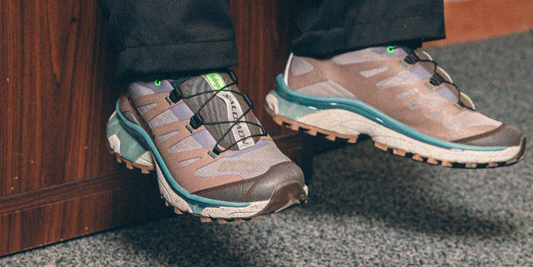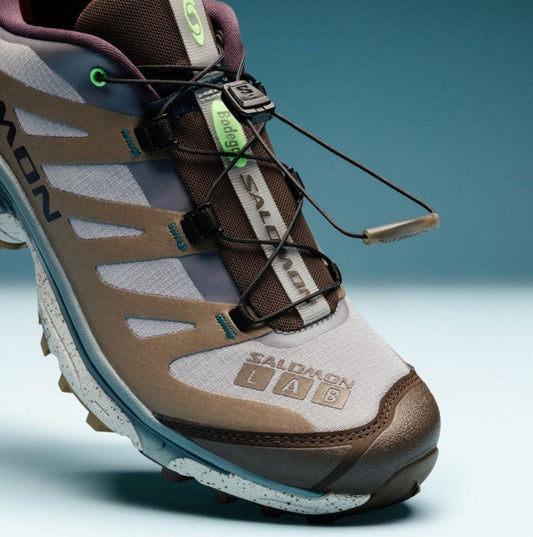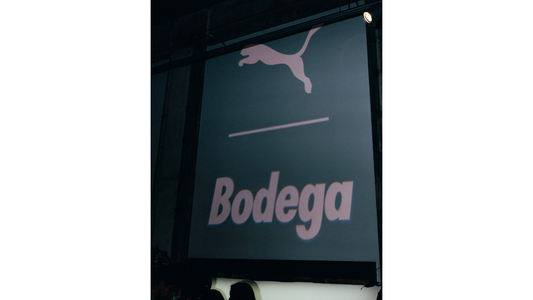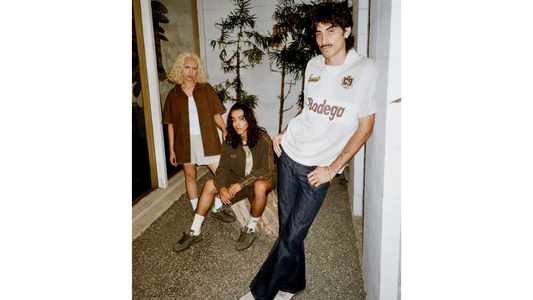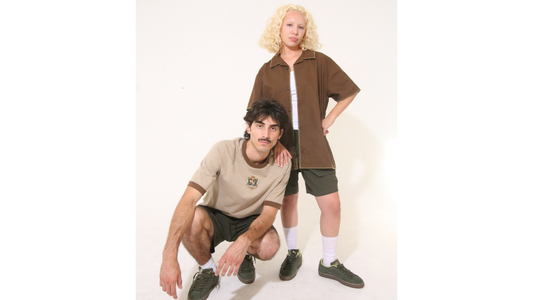Ever since the dawn of eco-friendly designs and proactive products for a greener tomorrow, humankind has been faced with the challenge of combining fashion and function to produce something both stylish and sustainable. Look at the first hybrid cars, sure it was an epic innovation, but we were stuck with the boxy, faux futuristic designs of the Prius. Whether everyone was trying too hard, or not hard enough, products deemed easy on the environment always seemed a little tough on the eye. Recently, however, Nike has reentered the conversation and settled the argument. With a focus on the future, Nike’s innovation team brings you a collection of stylish, eco-friendly silhouettes known as the “Space Hippie,” proving once and for all that sustainability and style can in fact co-exist.
Bodega caught up with Noah Murphy-Reinhertz, sustainability design lead at Nike’s Innovation Kitchen, to talk about the concept and creation of Nike’s new “Space Hippie” releases. The four silhouettes, inspired by Life on Mars, are linked through the limitations of creating only with materials on hand, and all part of Nike’s “Move to Zero,” a comprehensive plan for sustainability to "help protect the future of sport" and an added goal to power facilities with 100% renewable energy by 2025 while operating with net-zero carbon emissions.
After speaking with Murphy-Reinhertz, we learn that the Space Hippie 04, released on July 3, is the lowest carbon footprint of any sneaker ever produced by Nike, clocking in at approximately 3.7 kgs of carbon per pair. And styles 01, 02 and 03, set to release this Thursday, are not far behind. With uppers constructed from t-shirts, plastic bottles and textile scraps, cushioning created from recycled Zoom X and a “Crater Foam” outsole which blends several different Nike foams with Grind rubber, these innovations aren't just some PR move to sell some well-designed sneakers with a singular flash-in-the-plan purpose. The design and inspiration behind the “Space Hippie” represent the next giant leap in Nike’s new approach to sustainability. And while many other companies may spend countless hours and dollars trying to find a classy, appetizing way of describing their list of materials, Nike is boldly and unapologetically calling it what it is… trash.
With the 04 selling out instantly two weeks ago, Space Hippies 01, 02 and 03 are set for release this Thursday. As Murphy-Reinhertz notes, “The 01 is really lightweight, like a zero gravity running shoe. The 02 is all about the recovery, hanging out in the biodome and relaxing. The 03 is more like a get-out-and-discover-the-surface-of-Mars kind of thing. We wanted each shoe to have a vibe that we wanted to push to the edge. That kept the story going and kept us inspired throughout the whole process.”
Told through these four new silhouettes, the eco-friendly ideals behind the “Space Hippie” have not only made Nike's intentions clear, but also clearly present a way for the world to look at the production and design of just about everything.
(The following interview with Noah Murphy-Reinhertz and has been edited for length. To see and hear the interview in its entirety, please watch the video below)
Bodega: I want to start with the idea that Space Hippie is trash transformed. What does that actually mean?
Noah Murphy-Reinhertz: Really, the big thing for us trying to create a collection that got to this new level of sustainability was reducing carbon emissions. It took awhile for us to figure out what that would be. When we landed on this idea that materials at the end of their life, destined for the waste bin, were the most abundant resources that we had, we had to say, “Let’s use those, but let’s do as little as possible to turn them into a shoe. What is it going to take? Let’s add as little heat, let’s add as little energy, but let’s start with waste and let’s make that into Nike— a real, amazing Nike product.” That was this journey of transformation. There were all kinds of things that went into that, different technical innovations, different design choices, but ultimately it came down to use the things that are there and do as little as you can to turn them into something new.
Bodega: It’s incredible. I really like how you and the team approached the design problem of trying to create the lowest carbon footprint of any sneaker ever made, and I believe you guys were successful in doing that. Nike has been on the forefront of sustainability for a long time. You had projects like “Trash Talk” sneakers back in ‘08 made from leather scraps, but that was just the uppers. Flyknit is an innovation that has been around for almost a decade and that started producing 60% less waste. The Space Hippie is different because you looked at all of the parts of the shoe.
NMR: Yes, you mention some of the things that have come before. We had a ton of things that inspired us. Looking back at Nike’s catalogue and heritage, using Flyknit in the shoes. It set a pretty high bar for us to get over with these. We knew we had to look at every single part of the shoe and really shift from just thinking about one element to everything all the way back into the processes involved in making the shoe— when we heat press things, when we mold things— each one of those has an energy input and we wanted to consider all of those. We went into a pretty deep life-cycle analysis on all of these parts. And sometimes that literally meant taking alligator clips and hooking them up to the machine and seeing how much energy it’s drawing when you’re going to mold the bottom of a shoe. Every single part of the shoe went through that kind of analysis. That’s where we get to determining the actual carbon emissions score. The “04” has the lowest, and that is about 3.7kg of carbon per pair. That’s awesome. We’re really proud of that number, but that’s just the beginning. Sustainability isn’t saying we’ve gotten to 3.7, we’re going to stay there and sustain that. We have to get to where there is no negative impact. That’s the idea behind “Move to Zero,” no negative impact on the world when making a product. But then we actually have to go even beyond that. We have to be thinking about the making of things to be something that also makes the world better. And that is a far-out-there future, but that’s what our design innovation team is all about. What would it take to get there? Let’s start trying to figure it out. So Space Hippie is a step on the way there.
Bodega: And Space Hippie also encapsulates what your design team was also thinking about as a framework. Say I was trapped on Mars like the Andy Weir novel, The Martian, I would only have the materials I brought with me, or the materials on Mars to create whatever I needed. I read that that was also part of your design ethos.
NMR: Yes, absolutely. And there was this crazy coincidence as we were looking back at the movie. The character in the movie is actually wearing a pair of Free Flyknits and those were the previous best carbon score because they’re such a minimal shoe. It was just such a perfect moment. But that idea became the world that we developed all of the design inside. We had this moment with the brainstorm where we were putting all these materials together and the name came out of that. People were shouting names out thinking about this scrappy reconstruction moment, and this idea of the space hippie came out of that. Then what we did is be sure to carry that out all the way through, to make sure there was this tension between high technology, which Nike is known for on the innovation side, but with this redefinition of what it means to use that, and what it means to change the culture of sustainability. We let that tension between those two things inform the design throughout. We really use that to just guide the process all the way through.
Bodega: It seems like even more constraints on an already difficult design problem because you’re adding on top of it the idea of not creating any new materials, but how our materials are produced, where the waste is, and turn those into something like the space waste yarn uppers. As far as the uppers, where did you source them from your facility or design space?
NMR: The yarn is one of the parts that is already out there in the world. This came from old t-shirts that had been discarded. We collected those here in the US actually. Those are blended with recycled plastic bottles and textile scraps from the factory, basically off-cuts from big rolls of fabric. We took all of that stuff and shredded it together. It was all waste that was already out there in the world. Textile waste from fashion is one of the most abundant things out there, so we decided to find a way to use that. The bed in the Crater foam and the Zoom X scrap came directly from the factory where we’re making the shoes, so you are literally taking the scrap from one production line bringing it over here and shred it up and then bring it over here and push it into the space hippie shoes. That was this fun moment of taking the most high tech foams that Nike was doing and contrasting it with t-shirts and bringing those things together and making something out of it.
Bodega: So the Crater Foam was created by putting old rubber into a grinder? Is that correct?
NMR: Yeah, when you see all the speckles in here, this is the rubber that is usually the outsole of the shoe and whenever you press those parts, it is literally like a waffle press. There is always a little bit of rubber that squeezes out around the sides. It gets peeled away, we put it through a grinder and you get these small chunks. We took that rubber chunk and compounded it with the foam. So when you take those and inject it into the mold, you get this texture out of that naturally. All these blisters and cracks and craters are different on every shoe that comes out. And as soon as we saw it we just knew it was “Crater Foam.” It’s name came right out of the material.
Bodega: You have that, and then you and then you also recycle Zoom X into the midsole. That technology is famous for being what Eliud Kipchoge wore when breaking the 2 hour marathon barrier. It’s the most comfortable midsole out there with energy return properties that scientists are still trying to figure out. Not only is it functional, but probably the most comfortable lifestyle shoe you have produced in a while.
NMR: When we picked up some of the first recycled Zoom X parts, they were so light that it felt like you could tie a balloon onto these shoes and they would just float away. Part of the innovation challenge with these was finding a way to get it to survive because that Zoom X foam, if you shred it on the pavement, will get torn up really quick. So the Crater Foam was a way to create an envelope around it and protect it and give you the traction and durability but also give you all of that soft Zoom X on the inside as you could. It was a really great breakthrough moment. There was a minute there where we thought we wouldn’t be able to use the Zoom X because it was so light. Because of that, it wasn’t durable enough, but the Crater Foam became the way to carry it all the way through.
Bodega: There was an interview with one of your co-designers, Haley Toelle, and she mentioned that Bill Bowerman was the original Space Hippie, and that the outsole of the Crater Foam was actually inspired by the waffle. Is that true?
NMR: Yeah, there are all of these elements that you get to draw from with Nike. The DNA, the design history, the cultural history of Nike is just so rich. It’s a wonderful place to be a designer because you have all of these things to pull from. The history and the community, it’s just fantastic. What we did was we took this classic waffle pattern, that’s what came out of that first waffle press moment where Bill Bowerman put this rubber mixture into a waffle maker in his kitchen and got yelled at for destroying this waffle maker that was supposed to be used for breakfast. We took that and we let it get warped and wavy and have that original waffle vibe, but added this idea of play and sustainability and have a little fun with it.
Bodega: I wanna shout out the process and another key designer on your team, James Zormeir. I see him in a lot of videos waving a drill around and chopping things apart. How do you start the process and get to the point where you decide you should start making a prototype. What is the design process for you Noah?
NMR: This shoe really had to start with an idea and the collection had to then be about communicating that idea. It started with reducing carbon emissions, but the minute we went beyond that inspiration, it was clear that we needed more than that. People connect with Nike product because it’s culturally relevant, because it’s performance relevant. That’s what pulls people in. The whole ethos of Space Hippie and the design process was, are we taking this inspiration of next level sustainability, and are we having fun with it? Each step of the way it was like, “Okay, has this gotten too heady? Are we taking ourselves too seriously? Are we being true to the science?” But at the same time are we allowing that to bring out the best in us and the positivity in us to tackle this problem in this way? The really amazing thing about working with this team is that each step along the way we would trade the shoes around and ask, “Does this make us smile? Does this make us laugh?” And it was a very prototype and physical process. That’s how we ended up with these three, and eventually four shoes. We could see how much these materials could do. We started off with the midsole, but as we built on top of it, each shoe had its own vibe and we started to push that to the edges. The 01 was really lightweight, like a zero gravity running shoe. The 02 is for the recovery, hanging out in the biodome and relaxing. The 03 is more like a get-out-and-discover-the-surface-of-Mars kind of thing. We wanted each shoe to have a vibe that we wanted to push to the edge. That kept the story going and kept us inspired throughout the whole process.
Bodega: I think what people should take away from this is that you didn’t just create a collection, you created a design toolbox that could be used across different collections and different product categories also influencing the whole direction of Nike as a brand.
NMR: Yeah, it was really key that this wasn’t just about this one release of product. It really had to be about opening up the aperture and widening our view of what performance materials are, bring trash into the conversation and make just about any Nike shoe with these materials. We right away started collaborating with teams, with women’s sportswear and how these materials could go into other types of shoes.
Bodega: Maybe we could see Space Yarn in apparel too, possibly?
NMR: Yeah, there’s a t-shirt, and we have to see what else we can get going.
Bodega: Maybe mock turtlenecks that you can hang your gold chain on? I don’t know; I don’t want to overstep my bounds in this interview. I have a question about the prototyping process. How many iterations do you think you went through before you came across something that was a usable product?
NMR: We have hundreds of prototypes. [Holds up a pair] This is where the 03 wound up. As raw as this feels, there was a stage where it was just a sock glued onto some tooling. Everytime you would make a prototype, you would try to figure out the carbon score, so each one had its own kind of measurement, but it’s constantly changing and evolving. Each shoe had maybe 40 prototypes that we went through. By the time we were finished we had a couple hundred prototypes just lying around. They’re chilling up in a room on campus right now and we have to figure out what to do with them.
Bodega: Well should you recycle the prototypes to lower the carbon footprint?! Or I could come by and take one off your hands. I don’t know it would probably raise the carbon footprint because I’m across the country.
NMR: [Laughs] If you bicycle over everything will be fine.
Bodega: That whole philosophy of everything you do, every part of the process, including how you get to work is reflected. Even your packing materials. I see that you use a vegetable based ink on the box. The box is totally different, it can be used as a shopping box for it. Are there any elements of the shoe that we missed that are a small little win as far as sustainability?
NMR: The Fast Fit system. One of the things that’s really unique is that we use the very first version of that system that came out. It’s actually stamped out on what we call the “saddle.” It says “Fast Fit 1.0.” We are constantly evolving that mechanism and making it smaller and lighter and easier to manufacture. By the time these shoes were in development, Nike had already moved to Fast Fit 2.0, but what we found was that there were several thousand of the Fast Fit 1.0 laying around in the factory. So we actually went back and redesigned the core of the shoe to use those Fast Fit 1.0 that were laying around. It’s a part of the shoe that you’re never going to see, but it was one of those key moments where we said, “If we are going to be true to this idea of using waste and really using what’s there already, let’s not leave those things sitting on the factory floor, let’s redesign the shoe so we can use left over in the factory.” It was an interesting time, it was a little stressful because we were already so far into the process, but it was one of those good things of saying there’s no need to let this innovation go to waste.
Bodega: I read somewhere that your model as a designer is “Start where you are and use what you’ve got.” So it seems that the Space Hippie is your philosophy encapsulated into a set of materials and a set of manufacturing processes, and in the end a desirable piece of art that people are camping out for, or rather entering raffles for.
NMR: The thing that was so amazing about involving that, that design philosophy really came not only out of my own life approach to design, but when we brought this team together, we said, “What is it that we are going to do?” So often you wait around for this next technological breakthrough and when we all sat down and looked at what we had, we said, “We can do something amazing with what is here.” There’s no reason to wait. It’s super key, the core message of Space Hippie is there’s no reason for us to wait for carbon sequestration or some other scientific breakthrough to start making a difference now. The same is true in economic life, in political life, in social life, all of these things. We are what we are today, and that’s the moment to start making change. And that’s what we wanted to do with the shoes is to start now.


